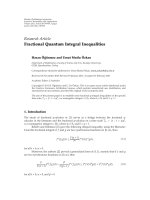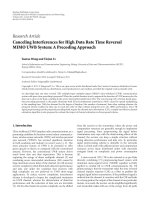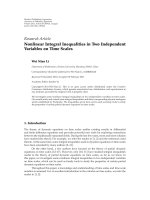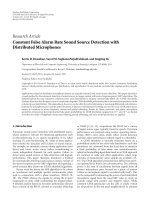Báo cáo hóa học: " Research Article Data Dependence for Ishikawa Iteration When Dealing with Contractive-Like Operators" potx
Bạn đang xem bản rút gọn của tài liệu. Xem và tải ngay bản đầy đủ của tài liệu tại đây (468.02 KB, 7 trang )
Hindawi Publishing Corporation
Fixed Point Theory and Applications
Volume 2008, Article ID 242916, 7 pages
doi:10.1155/2008/242916
Research Article
Data Dependence for Ishikawa Iteration When
Dealing with Contractive-Like Operators
S¸.M.S¸oltuz
1, 2
and Teodor Grosan
3
1
Departamento de Matematicas, Universidad de los Andes, Carrera 1 No. 18A-10, Bogota, Colombia
2
The Institute of Numerical Analysis, P.O. Box 68-1, Cluj-Napoca, Romania
3
Department of Applied Mathematics, Babes-Bolyai University, Cluj-Napoca, Romania
Correspondence should be addressed to Teodor Grosan,
Received 13 February 2008; Accepted 27 May 2008
Recommended by Hichem Ben-El-Mechaiekh
We prove a convergence result and a data dependence for Ishikawa iteration when applied to
contraction-like operators. An example is given, in which instead of computing the fixed point of
an operator, we approximate the operator with a contractive-like one. For which it is possible to
compute the fixed point, and therefore to approximate the fixed point of the initial operator.
Copyright q 2008 S¸. M. S¸oltuz and T. Grosan. This is an open access article distributed under
the Creative Commons Attribution License, which permits unrestricted use, distribution, and
reproduction in any medium, provided the original work is properly cited.
1. Introduction
Let X be a real Banach space; let B ⊂ X be a nonempty convex closed and bounded set. Let
T, S : B → B be two maps. For a given x
0
,u
0
∈ B, we consider the Ishikawa iteration see 1
for T and S:
x
n1
1 − α
n
x
n
α
n
Ty
n
,y
n
1 − β
n
x
n
β
n
Tx
n
, 1.1
u
n1
1 − α
n
u
n
α
n
Sv
n
,v
n
1 − β
n
u
n
β
n
Su
n
, 1.2
where {α
n
}⊂0, 1, {β
n
}⊂0, 1, and
lim
n→∞
α
n
lim
n→∞
β
n
0,
∞
n1
α
n
∞. 1.3
Set β
n
0, ∀n ∈ N, to obtain the Mann iteration, see 2.
The map T is called Kannan mappings, see 3, if there exists b ∈ 0, 1/2 such that for
all x, y ∈ B,
Tx − Ty≤b
x − Tx y − Ty
. 1.4
2 Fixed Point Theory and Applications
Similar mappings are Chatterjea mappings, see 4, for which there exists c ∈ 0, 1/2
such that for all x, y ∈ B,
Tx − Ty≤c
x − Ty y − Tx
. 1.5
Zamfirescu collected these classes. He introduced the following definition, see 5.
Definition 1.1 see 5, 6. The operator T : X→X satisfies condition Z Zamfirescu condition
if and only if there exist the real numbers a, b, c satisfying 0 <a<1, 0 <b, c<1/2 such that
for each pair x, y in X, at least one condition is true:
iz
1
Tx− Ty≤a x − y,
iiz
2
Tx− Ty≤b x − Tx y − Ty,
iiiz
3
Tx− Ty≤c x − Ty y − Tx.
It is known, see Rhoades 7,thatz
1
, z
2
,andz
3
are independent conditions.
Consider x, y ∈ B. Since T satisfies condition Z, at least one of the conditions from z
1
, z
2
,
and z
3
is satisfied. If z
2
holds, then
Tx − Ty≤b
x − Tx y − Ty
≤ b
x − Tx
y − x x − Tx Tx − Ty
.
1.6
Thus
1 − bTx − Ty≤bx − y 2bx − Tx. 1.7
From 0 ≤ b<1oneobtains,
Tx − Ty≤
b
1 − b
x − y
2b
1 − b
x − Tx. 1.8
If z
3
holds, then one gets
Tx − Ty≤c
x − Ty y − Tx
≤ c
x − Tx Tx − Ty x − y x − Tx
1.9
Hence,
1 − cTx − Ty≤cx − y 2cx − Tx, 1.10
that is,
Tx − Ty≤
c
1 − c
x − y
2c
1 − c
x − Tx. 1.11
Denote
δ : max
a,
b
1 − b
,
c
1 − c
, 1.12
S¸. M. S¸oltuz and T. Grosan 3
to obtain
0 ≤ δ<1. 1.13
Finally, we get
Tx − Ty≤δx − y 2δx − Tx, ∀x, y ∈ B. 1.14
Formula 1.14 was obtained a s in 8.
Osilike and Udomene introduced in 9 a more general definition of a quasicontractive
operator; they considered the operator for which there exists L ≥ 0andq ∈ 0, 1 such that
Tx − Ty≤qx − y Lx − Tx, ∀x, y ∈ B. 1.15
Imoru and Olatinwo considered in 10 , the following general definition. Because they
failed to name them, we will call them here contractive-like operators.
Definition 1.2. One calls contractive-like
the operator T if there exist a constant q ∈ 0, 1 and a
strictly increasing and continuous function φ : 0, ∞→0, ∞ with φ00 such that for each
x, y ∈ X,
Tx − Ty≤qx − y φ
x − Tx
. 1.16
In both papers 9, 10,theT-stability of Picard and Mann iterations was studied.
2. Preliminaries
The data dependence abounds in literature of fixed point theory when dealing with Picard-
Banach iteration, but is quasi-inexistent when dealing with Mann-Ishikawa iteration. As far
as we know, the only data-dependence result concerning Mann-Ishikawa iteration is in 11.
There, the data dependence of Ishikawa iteration was proven when applied to contractions.
In this note, we will prove data-dependence results for Ishikawa iteration when applied
to the above contractive-like operators. Usually, Ishikawa iteration is more complicated but
nevertheless more stable as Mann iteration. There is a classic example, see 12, in which
Mann iteration does not converge while Ishikawa iteration does. This is the main reason for
considering Ishikawa iteration in Theorem 3.2.
The following remark is obvious by using the inequality 1 − x ≤ expx, ∀x ≥ 0.
Remark 2.1. Let
{θ
n
} be a nonnegative sequence such that θ
n
∈ 0, 1, ∀n ∈ N. If
∞
n1
θ
n
∞, then
∞
n1
1 − θ
n
0.
The following is similar to lemma from 13. Note that another proof for this lemma
13 can be found in 11.
Lemma 2.2. Let {a
n
} be a nonnegative sequence for which one supposes there exists n
0
∈ N, such that
for all n ≥ n
0
one has satisfied the following inequality:
a
n1
≤
1 − λ
n
a
n
λ
n
σ
n
, 2.1
where λ
n
∈ 0, 1, ∀n ∈ N,
∞
n1
λ
n
∞, and σ
n
≥ 0 ∀n ∈ N.Then,
0 ≤ lim
n→∞
sup a
n
≤ lim
n→∞
sup σ
n
. 2.2
4 Fixed Point Theory and Applications
Proof. There exists n
1
∈ N such that σ
n
≤ lim sup σ
n
, ∀n ≥ n
1
. Set n
2
max{n
0
,n
1
} such that
the following inequality holds, for all n ≥ n
2
:
a
n1
≤
1 − λ
n
1 − λ
n−1
···
1 − λ
n
1
a
n
1
lim
n→∞
sup σ
n
. 2.3
Using the above Remark 2.1 with θ
n
λ
n
, we get the conclusion. In order to prove 2.3,
consider 2.1 and the induction step:
a
n2
≤
1 − λ
n1
a
n1
λ
n1
σ
n1
≤
1 − λ
n1
1 − λ
n
1 − λ
n−1
···
1 − λ
n
1
a
n
1
1 − λ
n1
lim
n→∞
sup σ
n
λ
n1
σ
n1
1 − λ
n1
1 − λ
n
1 − λ
n−1
···
1 − λ
n
1
a
n
1
lim
n→∞
sup σ
n
.
2.4
3. Main results
Theorem 3.1. Let X be a real Banach space, B ⊂ X a nonempty convex and closed set, and T : B→B a
contractive-like map with x
∗
being the fixed point. Then for all x
0
∈ B, the iteration 1.1 converges to
the unique fixed point of T.
Proof. The uniqueness comes from 1.16; supposing we have two fixed points x
∗
and y
∗
, we
get
x
∗
− y
∗
Tx
∗
− Ty
∗
≤qx
∗
− y
∗
φ
x
∗
− Tx
∗
qx
∗
− y
∗
, 3.1
that is, 1 − qx
∗
− y
∗
0. From 1.1 and 1.16 we obtain
x
n1
− x
∗
≤
1 − α
n
x
n
− x
∗
α
n
Ty
n
− Tx
∗
≤
1 − α
n
x
n
− x
∗
α
n
q
y
n
− x
∗
≤
1 − α
n
x
n
− x
∗
α
n
q
1 − β
n
x
n
− x
∗
qα
n
β
n
Tx
n
− Tx
∗
≤
1 − α
n
1 − q
1 − 1 − qβ
n
x
n
− x
∗
≤
1 − α
n
1 − q
x
n
− x
∗
≤···≤
n
k1
1 − α
k
q
x
0
− x
∗
.
3.2
Use Remark 2.1 with θ
k
α
k
q to obtain the conclusion.
This result allows us to formulate the following data dependence theorem.
Theorem 3.2. Let X be a real Banach space, let B ⊂ X be a nonempty convex and closed set, and let
ε>0 be a fixed number. If T : B→B is a contractive-like operator with the fixed point x
∗
and S : B→B
is an operator with a fixed point u
∗
, (supposed nearest to x
∗
) , and if the following relation is satisfied:
Tz− Sz≤ε, ∀z ∈ B, 3.3
S¸. M. S¸oltuz and T. Grosan 5
then
x
∗
− u
∗
≤
ε
1 − q
. 3.4
Proof. From 1.1 and 1.2,wehave
x
n1
− u
n1
1 − α
n
x
n
− u
n
α
n
Ty
n
− Sv
n
. 3.5
Thus
x
n1
− u
n1
1 − α
n
x
n
− u
n
α
n
Sv
n
− Ty
n
≤
1 − α
n
x
n
− u
n
α
n
Sv
n
− Tv
n
Tv
n
− Ty
n
≤
1 − α
n
x
n
− u
n
α
n
Tv
n
− Sv
n
α
n
Tv
n
− Ty
n
≤
1 − α
n
x
n
− u
n
α
n
ε qα
n
y
n
− v
n
α
n
φ
y
n
− Ty
n
≤
1−α
n
x
n
−u
n
α
n
εqα
n
1 − β
n
x
n
−u
n
qα
n
β
n
Tx
n
−Su
n
α
n
φ
y
n
−Ty
n
≤
1 − α
n
x
n
− u
n
α
n
ε qα
n
1 − β
n
x
n
− u
n
α
n
β
n
q
Tx
n
− Tu
n
Tu
n
− Su
n
α
n
φ
y
n
− Ty
n
≤
1 − α
n
x
n
− u
n
α
n
ε qα
n
1 − β
n
x
n
− u
n
q
2
α
n
β
n
x
n
− u
n
qα
n
β
n
φ
x
n
− Tx
n
qα
n
β
n
ε α
n
φ
y
n
− Ty
n
1 − α
n
1 − q
1 − β
n
− β
n
q
2
x
n
− u
n
α
n
ε qα
n
β
n
ε
qα
n
β
n
φ
x
n
− Tx
n
α
n
φ
y
n
− Ty
n
1−α
n
1−q
1qβ
n
x
n
−u
n
α
n
qβ
n
φ
x
n
−Tx
n
φ
y
n
−Ty
n
qβ
n
εε
≤
1−α
n
1−q
x
n
−u
n
α
n
1 − q
qβ
n
φ
x
n
−Tx
n
φ
y
n
−Ty
n
qβ
n
εε
1 − q
.
3.6
Note that lim
n→∞
φx
n
− Tx
n
lim
n→∞
φy
n
− Ty
n
0 because φ is a continuous map and
both {x
n
}, {y
n
} converge to the fixed point of T. Set
λ
n
: α
n
1 − q,
σ
n
:
qβ
n
φ
x
n
− Tx
n
φ
y
n
− Ty
n
qβ
n
ε ε
1 − q
,
3.7
6 Fixed Point Theory and Applications
and use Lemma 2.2 to obtain the conclusion
x
∗
− u
∗
≤
ε
1 − q
. 3.8
Remark 3.3. i Set β
n
0, ∀n ∈ N, to obtain the data dependence for Mann iteration.
ii The Zamfirescu operators and implicitly Chatterjea and Kannan are contractive-like
operators, therefore our Theorem 3.2 remains true for these classes.
4. Numerical example
The following example follows the example from 8.
Example 4.1. Let T :
R→R be given by
Tx 0, if x ∈ −∞, 2
−0.5, if x ∈ 2, ∞.
4.1
Then T is contractive-like operator with q 0.2andφ identity.
Note the unique fixed point is 0. Consider now the map S : R→R,
Sx 1, if x ∈ −∞, 2
−1.5, if x ∈ 2, ∞
4.2
with the unique fixed point 1. Take ε to be the distance between the two maps as follows:
Sx − Tx≤1, ∀x ∈
R. 4.3
Set u
0
x
0
0, α
n
β
n
1/n 1. Independently of above theory, the Ishikawa iteration
applied to S, leads to
Iteration step Ishikawa iteration
10.5
10 0.9
100 0.99
4.4
Note that for n 1,
0.5
1
n 1
0
1
n 1
S
1
2
, 4.5
since y
1
1/n 10 1/n 11 1/2. The above computations can be obtained also
by using a Matlab program. This leads us to “conclude” that Ishikawa iteration applied to S
converges to fixed point, x
∗
1. Eventually, one can see that the distance between the two
fixed points is one. Actually, without knowing the fixed point of S and without computing it,
via Theorem 3.2, we can do the following estimate for it:
x
∗
− u
∗
≤
1
1 − q
1
1 − 0.2
10
8
1.2. 4.6
As a conclusion, instead of computing fixed points of S, choose T more closely to S and the
distance between the fixed points will shrink too.
S¸. M. S¸oltuz and T. Grosan 7
Acknowledgments
The authors are indebted to referee for carefully reading the paper and for making useful
suggestions. This work was supported by CEEX ET 90/2006-2008.
References
1 S. Ishikawa, “Fixed points by a new iteration method,” Proceedings of the American Mathematical Society,
vol. 44, no. 1, pp. 147–150, 1974.
2 W. R. Mann, “Mean value methods in iteration,” Proceedings of the American Mathematical Society,vol.
4, no. 3, pp. 506–510, 1953.
3 R. Kannan, “Some results on fixed points,” Bulletin of the Calcutta Mathematical Society, vol. 60, pp.
71–76, 1968.
4 S. K. Chatterjea, “Fixed-point theorems,” Comptes Rendus de l’Acad
´
emie Bulgare des Sciences, vol. 25, pp.
727–730, 1972.
5 T. Zamfirescu, “Fix point theorems in metric spaces,” Archiv der Mathematik, vol. 23, no. 1, pp. 292–298,
1972.
6 B. E. Rhoades, “Fixed point iterations using infinite matrices,” Transactions of the American Mathematical
Society, vol. 196, pp. 161–176, 1974.
7 B. E. Rhoades, “A comparison of various definitions of contractive mappings,” Transactions of the
American Mathematical Society, vol. 226, pp. 257–290, 1977.
8 V. Berinde, “On the convergence of the Ishikawa iteration in the class of quasi contractive operators,”
Acta Mathematica Universitatis Comenianae, vol. 73, no. 1, pp. 119–126, 2004.
9 M. O. Osilike and A. Udomene, “Short proofs of stability results for fixed point iteration procedures
for a class of contractive-type mappings,” Indian Journal of Pure and Applied Mathematics,vol.30,no.
12, pp. 1229–1234, 1999.
10 C. O. Imoru and M. O. Olatinwo, “On the stability of Picard and Mann iteration processes,” Carpathian
Journal of Mathematics, vol. 19, no. 2, pp. 155–160, 2003.
11 S¸. M. S¸oltuz, “Data dependence for Ishikawa iteration,” Lecturas Matem
´
aticas, vol. 25, no. 2, pp. 149–
155, 2004.
12 C. E. Chidume and S. A. Mutangadura, “An example of the Mann iteration method for Lipschitz
pseudocontractions,” Proceedings of the American Mathematical Society, vol. 129, no. 8, pp. 2359–2363,
2001.
13 J. A. Park, “Mann-iteration process for the fixed point of strictly pseudocontractive mapping in some
Banach spaces,” Journal of the Korean Mathematical Society, vol. 31, no. 3, pp. 333–337, 1994.









